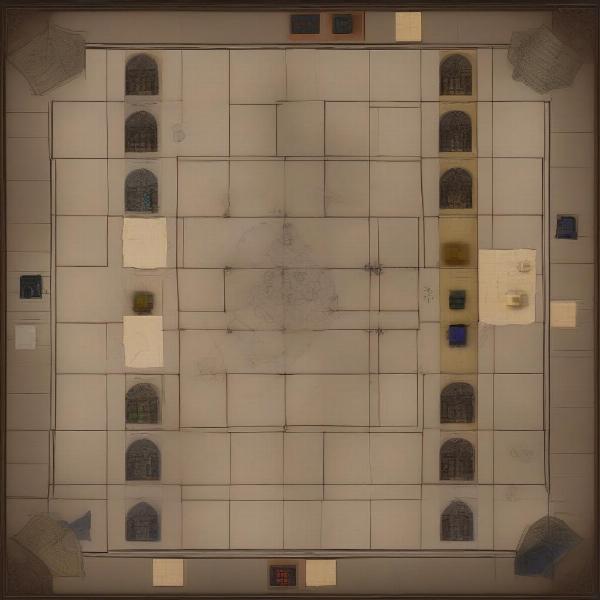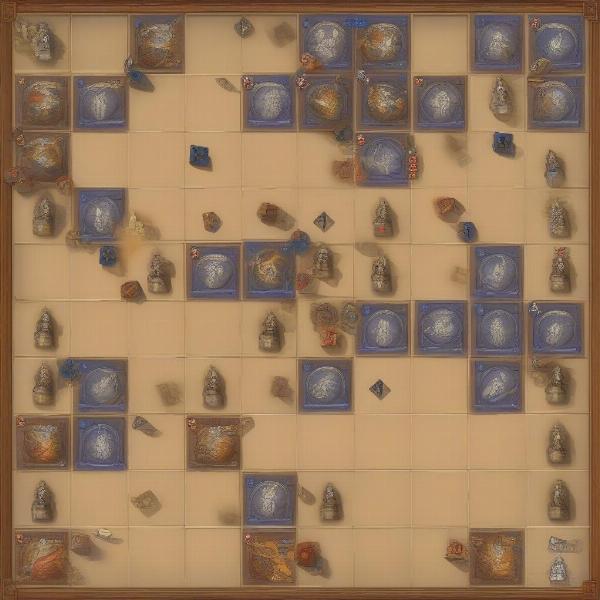Cathedral is a strategy board game for two players that combines simple rules with deep strategic gameplay. The goal is to surround your opponent’s pieces with your own, ultimately forcing them to place their final piece. Learning how to play Cathedral is easy, but mastering its intricacies can take a lifetime. This guide will cover everything you need to know, from the basic rules to advanced strategies.
Setting Up the Game
The Cathedral board is a square grid. Each player has a set of pieces of various shapes and sizes, representing different parts of a cathedral complex. One player controls the light-colored pieces, the other the dark. The game begins with the board empty except for the central square, which is neutral territory.
Gameplay Basics
Players take turns placing one piece at a time onto the board. Pieces must be placed entirely within the grid and cannot overlap any other pieces, including their own. The key to winning is strategically positioning your pieces to enclose your opponent’s pieces within your territory. An enclosed piece is one that is completely surrounded by the opponent’s pieces and the edge of the board. A player loses when they cannot legally place any more of their pieces.
Strategic Piece Placement: Mastering the Art of Territory Control
The seemingly simple act of placing a piece in Cathedral can be surprisingly complex. Each piece has its strengths and weaknesses, and knowing when and where to deploy them is crucial. Larger pieces are powerful for claiming large areas, but they can also become easy targets if not positioned carefully. Smaller pieces offer flexibility, allowing you to fill gaps and complete enclosures, but they can be less effective in early game territory grabs. Consider the board state carefully before every move, anticipate your opponent’s responses, and aim to create multiple placement options for yourself while limiting those of your opponent.
 Cathedral board game setup with all pieces
Cathedral board game setup with all pieces
Utilizing the Neutral Square: A Strategic Advantage
The neutral central square adds a unique dynamic to Cathedral. No piece can be placed so that it covers this square. This seemingly small restriction significantly impacts gameplay, creating obstacles and influencing placement strategies. Use the neutral square to your advantage by forcing your opponent to make suboptimal placements or by using it as part of your own enclosing strategy. Skilled players can manipulate the space around the neutral square to create traps and secure victory.
Advanced Strategies: Thinking Ahead and Anticipating Your Opponent
As you gain experience, you’ll learn to think several steps ahead. Try to anticipate your opponent’s moves and plan your placements accordingly. Look for opportunities to create multiple enclosures at once or to force your opponent into a position where they have no legal moves left. Mastering this anticipatory skill is what separates good players from great ones.
 Mid-game Cathedral showing strategic piece placement
Mid-game Cathedral showing strategic piece placement
Common Mistakes to Avoid
One common mistake beginners make is focusing too much on building their own cathedral without considering their opponent’s moves. Another mistake is placing large pieces too early in the game, making them vulnerable to being enclosed. By avoiding these common pitfalls and practicing regularly, you can significantly improve your game.
Variations and House Rules
While the standard rules provide a challenging and engaging game, some players enjoy adding variations. One popular variation is to allow players to place pieces adjacent to the central neutral square, increasing the strategic complexity. Experiment with different house rules to find what you enjoy most.
Why Cathedral Remains a Timeless Classic
Cathedral’s enduring appeal lies in its simple yet profound gameplay. The rules are easy to learn, but the strategic depth is immense. Each game is a unique puzzle, offering endless replayability. This combination of accessibility and strategic richness is what makes Cathedral a true classic.
 End game scenario in Cathedral board game
End game scenario in Cathedral board game
Conclusion
Cathedral is a rewarding game that offers a satisfying blend of strategy and simplicity. By understanding the basic rules, mastering strategic piece placement, and learning to anticipate your opponent’s moves, you can become a skilled Cathedral player. Now that you know how to play Cathedral, challenge your friends and family and experience the strategic depth of this classic board game.
FAQ
-
How many players can play Cathedral? Cathedral is designed for two players.
-
How long does a typical game of Cathedral last? Games typically last between 15 and 30 minutes.
-
What happens if both players cannot place any more pieces? The game ends in a draw.
-
Is there an official online version of Cathedral? Yes, several online platforms offer digital versions of Cathedral.
-
What is the best strategy for winning Cathedral? There’s no single “best” strategy, but focusing on enclosing your opponent’s pieces while protecting your own is key.
-
Can I play Cathedral solo? While designed for two players, you can explore solo variations by setting challenges for yourself, such as trying to enclose all your pieces within a specific area.
-
Where can I buy a Cathedral board game? Cathedral is available at most game stores and online retailers.

